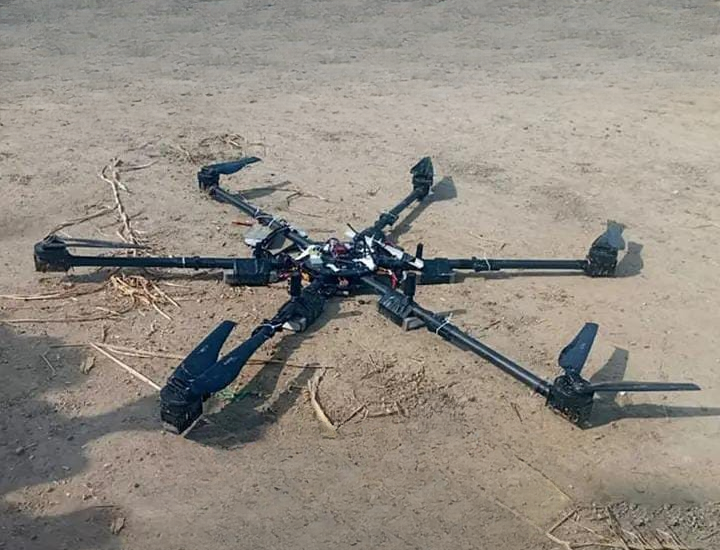In a fresh incident along the tense Pakistan–India border, Pakistani Forces Shoot Down Indian Surveillance Drone Near Lahore The drone, allegedly violating Pakistan’s airspace, was detected in the early hours of the morning before being brought down by precise fire from ground units. The incident has once again heightened tensions between the two nuclear-armed neighbors, whose relations have been strained for decades.
Incident Details
According to the Inter-Services Public Relations (ISPR), the media wing of the Pakistan Armed Forces, the unmanned aerial vehicle (UAV) was spotted entering Pakistani territory from the Indian side of the border in the Shakargarh sector, close to Lahore. Border surveillance radars and visual observation posts quickly identified the object as a hostile surveillance drone.
The ISPR stated that the drone was flying at low altitude, likely to avoid radar detection, and was conducting reconnaissance along sensitive border areas. It was engaged by Pakistani troops using small arms fire, and was successfully shot down before it could return to Indian territory.
The debris of the drone has been recovered and sent to a technical analysis team for further inspection. Early assessments suggest that it was equipped with a high-resolution camera system, likely intended for collecting intelligence on Pakistani military positions and movement patterns.X
Official Response from Pakistan
Following the incident, Pakistan lodged a strong protest with India through diplomatic channels, condemning the breach of its airspace as a violation of international law and bilateral agreements. The Pakistani Foreign Office called the incident “a clear act of aggression” and warned that such provocations could lead to “serious consequences” for regional peace and stability.
Pakistan maintains that incidents of this nature undermine efforts to reduce tensions along the border. Officials reiterated that while Pakistan desires peaceful coexistence, its armed forces remain fully capable of defending the country’s territorial integrity.
Historical Context
Drone incursions along the Pakistan–India border are not new. Over the past decade, several similar incidents have been reported, especially along the Line of Control (LoC) in Kashmir. In many cases, these UAVs have been used for reconnaissance and intelligence gathering.
In 2020, Pakistani forces shot down at least four Indian surveillance drones in separate incidents. Each time, Pakistan accused India of violating its sovereignty, while India either remained silent or claimed that the drones were used for border monitoring on its side of the boundary.
These drone activities are often linked to the long-standing territorial disputes between the two nations, particularly over Kashmir, which both countries claim in full but control in part. The border areas are heavily militarized, with regular skirmishes and occasional exchanges of fire.
Indian Side’s Likely Position
While India had yet to issue an official statement at the time of reporting, it has previously justified such drone flights as part of routine security operations aimed at preventing cross-border infiltration by militants. However, Pakistan insists that even if these drones are on reconnaissance missions, crossing the internationally recognized boundary is unacceptable.
Analysts note that India may downplay or deny such incidents to avoid diplomatic escalation, while Pakistan often makes them public to highlight what it sees as Indian aggression.
Technical Aspects of the Drone
Initial images released by Pakistani authorities show the remains of a small, fixed-wing UAV with a wingspan of about two meters. Military experts believe it is similar to commercially modified drones often used for tactical reconnaissance. The presence of GPS navigation, infrared sensors, and a high-resolution camera indicates it was meant for day and night surveillance.
According to security analysts, drones like this can fly at low altitudes for several hours and are ideal for monitoring troop movement, mapping terrain, and collecting data without risking human pilots. This makes them a favored tool in sensitive border areas, but also a source of contention when they cross into another country’s territory.
Implications for Regional Security
The downing of the drone adds yet another layer of strain to already fragile Pakistan–India relations. It comes at a time when both countries have been making tentative diplomatic gestures to reduce tensions. However, security incidents along the border can quickly derail such efforts.
Military analysts warn that drone incursions, while less dangerous than manned aircraft violations, still carry the risk of escalation. If such incidents become more frequent, they could lead to a cycle of retaliation, potentially involving more aggressive military responses.
The use of surveillance drones also reflects a broader trend in modern military strategy, where unmanned systems are becoming an essential part of intelligence gathering. While they reduce risk to personnel, they also make it easier for nations to conduct operations in contested or sensitive areas, sometimes pushing the boundaries of international norms.
Public Reaction in Pakistan
The news of the drone shootdown has been widely covered in Pakistani media, with many commentators framing it as evidence of the military’s vigilance and capability. Social media users have praised the armed forces for their quick response and readiness to defend national borders. READ NEXT https://elevenpakistan.com/italian-lawmakers-wear-flag-support-palestine/
At the same time, some voices in Pakistan have called for stronger diplomatic action, including taking the matter to the United Nations or other international bodies to highlight repeated violations of sovereignty.
Conclusion
The shooting down of an Indian surveillance drone near Lahore is a reminder of the fragile state of Pakistan–India relations, where even small-scale incidents can carry significant political and security implications. For Pakistan, it is another example of what it views as Indian provocations. For India, it is likely to be portrayed as a routine matter exaggerated by the other side.
In the broader picture, such incidents underline the urgent need for both countries to establish clearer protocols for unmanned aerial vehicle operations along their shared border. Without such measures, the risk of miscalculation—and the potential for escalation—will remain high.
Until then, every drone crossing the line will be more than just a piece of technology—it will be a potential spark in one of the most volatile rivalries in the world.
READ NEXT



